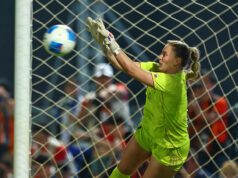Even now, the controversial call that overturned a crucial out in the bottom of the seventh inning of Game One of the National League Championship Series (NLCS) remains a hot topic of discussion in baseball circles. Judging from the reactions in social media and of armchair pundits, the verdict is split. One side has argued that Willson Contreras violated a rule by blocking home plate before receiving the pass. The other has claimed that Charlie Culberson was rightly called out following a heads-up play. “All rules or laws aren’t necessarily good ones,” argued Cubs manager Joe Maddon, who was tossed for contesting the decision following a review prompted by the Dodgers’ protest. “That was a beautifully done major league play that gets interpreted tantamount to the soda tax in Chicago.”
Were tradition the sole determinant, Maddon would be right. The sport’s annals are littered with examples of catchers protecting home plate by blocking the path of the base runner with or without the ball in their hands. Since Rule 7.13 was instituted in 2014, however, examples have dwindled; “unless the catcher is in possession of the ball,” it notes, “the catcher cannot block the pathway of the runner as he is attempting to score. If, in the judgment of the umpire, the catcher without possession of the ball blocks the pathway of the runner, the umpire shall call or signal the runner safe.” And considering how Contreras’ tag of Culberson unfolded, the aforesaid provision applies.
The replay is clear. Contreras stuck his left leg out to prevent the left hand of Culberson, who actually tried to avoid him by sliding to his side, from touching home plate. And, nope, the ball was not yet with him when he did so. Parenthetically, it bears pointing out that had the rule not been in place, he would likely have been the target of a vicious takedown aimed at making him lose possession of the ball. In other words, the edict succeeded in its objective; it prevented him from incurring injury.
Don’t tell that to Maddon, though. As far as he’s concerned, the rule underscores just how soft pro baseball has become. He spoke out against it long before Game One of the NLCS, and will continue to do so, especially after it was applied to his detriment. In fact, he has already talked to Major League Baseball chief baseball officer Joe Torre about it over the phone, and plans to “have [a] sit-down face to face about what I said.” Needless to say, he has Contreras agreeing with him. “I think we need to go to WalMart, get some toys, and then play,” the catcher said.
In any case, Maddon would do well to look beyond crew chief Mike Winters’ decision in assessing the cause of the Cubs’ Game One loss. For this, the blame lies squarely on the shoulders of those who comprise the bullpen; heading into Game Two, they sported an atrocious 6.97 earned run average through the postseason, reflecting location issues that have plagued them from the All-Star break. And these were evident anew yesterday, with John Lackey giving up a three-run, walk-off homer via a middle-of-the-zone fastball. Incidentally, in no instance was Rule 7.13 invoked.
Anthony L. Cuaycong has been writing Courtside since BusinessWorld introduced a Sports section in 1994. He is the Senior Vice-President and General Manager of Basic Energy Corp.



